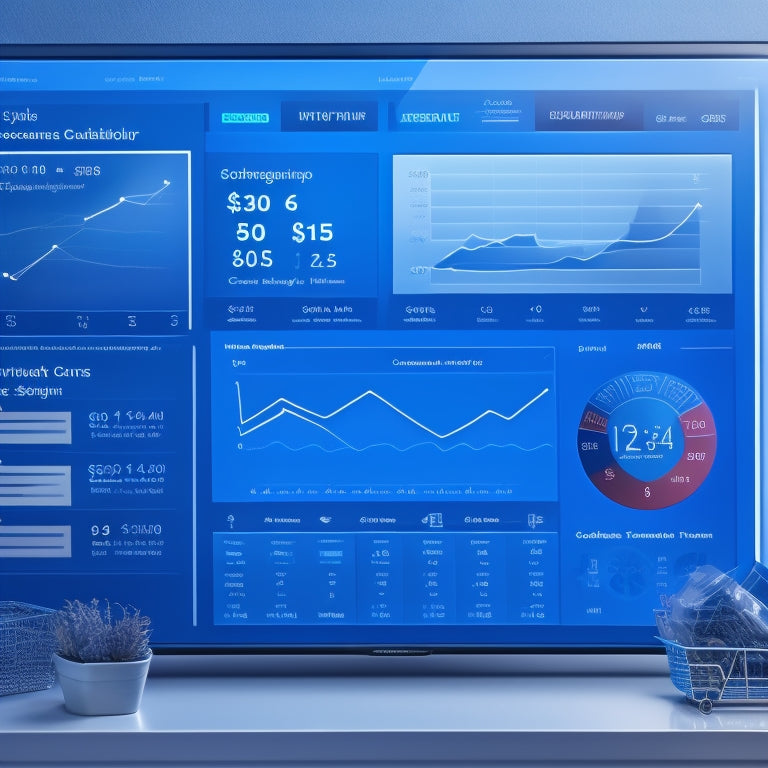
3 Essential Metrics for Ecommerce Profitability
Share
You're likely leaving money on the table if you're not tracking the right metrics. To maximize ecommerce profitability, focus on three essential metrics. First, measure the ROI of each digital product to identify your most profitable items and areas for improvement. Next, optimize customer acquisition costs by analyzing conversion rates and pinpointing ineffective marketing strategies. Finally, track lifetime value performance to quantify total revenue per customer and inform data-driven decisions. By mastering these metrics, you'll reveal insights that can take your ecommerce business to the next level - and there's even more to explore when you drill deeper into the data.
Key Takeaways
• Track ROI of each digital product to determine the most profitable ones and allocate resources effectively.
• Analyze conversion rates to identify opportunities for revenue growth and optimize the sales process.
• Monitor customer acquisition costs to focus on profitable products and optimize sales funnel stages.
• Measure customer lifetime value to quantify total revenue per customer and gain insights into customer behavior.
• Utilize metrics to inform data-driven decisions and drive revenue growth through pricing, inventory management, and marketing strategies.
Measuring Digital Product ROI
You need to track the return on investment (ROI) of each digital product to determine which ones are generating the most profit and identify areas for improvement. By doing so, you'll be able to allocate resources more effectively and make data-driven decisions to drive revenue growth.
To calculate ROI, you'll need to take into account the cost of producing and marketing each product, as well as the revenue generated from sales. A high ROI indicates a profitable product, while a low ROI suggests areas for improvement or potential cuts.
Analyzing conversion rates is also critical in measuring digital product ROI. A high conversion rate indicates that your marketing efforts are paying off, while a low conversion rate may suggest issues with your sales funnel or product offering. By tracking conversion rates, you can identify opportunities to optimize your sales process and increase revenue.
Optimizing Customer Acquisition Costs
By understanding which digital products drive profitability, you can now focus on optimizing customer acquisition costs to maximize ROI. To do this, you need to analyze your conversion rates and pinpoint areas for improvement in your marketing strategies. Identify the most effective channels driving sales and allocate your budget accordingly.
Next, examine your sales funnel to identify bottlenecks and optimize each stage to increase conversions. For instance, if you notice a high drop-off rate during checkout, consider streamlining the process or offering incentives to complete the purchase.
Furthermore, don't overlook the importance of customer retention in reducing customer acquisition costs. Focus on building strong relationships with your customers to encourage repeat business and positive word-of-mouth. By doing so, you can reduce the need for costly marketing campaigns and allocate resources more efficiently.
Tracking Lifetime Value Performance
Tracking lifetime value (LTV) performance allows ecommerce businesses to quantify the total revenue a customer generates over their lifetime, providing an essential metric for measuring profitability and informing data-driven decisions.
By monitoring LTV, you'll gain valuable insights into customer behavior, identifying opportunities to improve customer retention and drive revenue growth.
Here are key aspects to focus on when tracking LTV performance:
-
Average Order Value (AOV): Monitor the average amount spent by customers in a single transaction to identify opportunities to increase revenue.
-
Purchase Frequency: Analyze how often customers return to make repeat purchases, and develop strategies to encourage loyalty.
-
Customer Churn Rate: Identify the percentage of customers lost over a specific period, and implement retention strategies to minimize churn.
-
Gross Margin: Calculate the profit margin on each sale to optimize pricing and inventory management.
-
Customer Segmentation: Group customers by LTV to tailor marketing efforts and resources to high-value segments.
Frequently Asked Questions
How Often Should I Review and Adjust My Ecommerce Metrics Strategy?
You should regularly review your ecommerce metrics strategy, ideally every 3-6 months, to adjust and refine it based on metric comparisons and product analysis, ensuring data-driven decisions that drive profitability and growth.
Can I Use Metrics From One Product Line for Another Product Line?
Did you know 71% of businesses struggle with metric consistency? When considering cross-product comparison, you'll find that strategic alignment is key. Don't assume metrics will translate; instead, adapt them for each product line, ensuring performance evaluation accuracy and informed decision-making.
What Is the Ideal Ratio of New Vs. Repeat Customers?
You're aiming for a 3:1 or 4:1 ratio of repeat to new customers, as this balance optimizes customer retention for revenue growth, while keeping acquisition costs in check to maximize lifetime value.
How Do I Handle Metrics Discrepancies Between Different Analytics Tools?
You're traversing a maze of conflicting data, where each analytics tool is a different path. To reconcile discrepancies, you'll need to harmonize metrics across platforms, ensuring data reconciliation through cross-platform comparison and precise metrics alignment.
What Metrics Should I Focus on During Holidays or Special Promotions?
During holidays or special promotions, you'll want to laser-focus on conversion rates, factoring in seasonality, to optimize sales. Also, keep a close eye on customer acquisition costs and conduct competitive analysis to stay ahead of the game.
Related Posts
-
Boost Conversions And Revenue With Reelup-Shoppable Videos
In today's digital age, businesses are constantly looking for innovative ways to boost conversions and revenue. Reel...
-

Closing the Merchant Digital Literacy Gap Online
You're likely leaving money on the table if you're not leveraging technology to reach more customers, increase sales,...
-

How Does the Shopify Blog Work
This article aims to provide an informative overview of the workings of the Shopify blog. The Shopify blog functions...

